Difference between revisions of "Testing Article1"
| Line 1: | Line 1: | ||
| − | ==About | + | ==About Managing the Legend== |
| − | + | The capability to use the '''color dimension''' in the chart to reflect differences between task bar/milestone symbols is one of the most significant features of OnePager. The '''Legend''' is the displayed component that '''communicates''' the '''meaning''' of each '''color''' and '''shape''' to your audience with respect to task bars and milestone symbols in the chart. Accordingly, OnePager provides you total control over the '''color dimension''' in your OnePager charts and snapshots through a control structure that begins when the chart is first '''created''' and throughout your project as needs change. The "Legend''' can be '''shown''' or '''hidden''' in the chart as your needs dictate, but a certain amount of thought about the '''color dimension''' is recommended before '''creating''' your first chart from your Microsoft Project or Excel '''source plan'''. | |
| − | + | If you are already knowledgeable about this subject, you may prefer to skip the next section and continue on at this section: [[Managing the Legend in the Chart for Version 7.0#Showing and Hiding the Legend | Showing and Hiding the Legend]] <!--15.1.1-70--> | |
| − | === | + | ===A Discussion On Setting the Color Dimension=== |
| − | + | When you are first '''creating''' a chart, your first opportunity to address the '''color dimension''' is when you select the Microsoft Project or Excel '''field''' that is to be used to create task bar/milestone symbol '''colors''' in the chart. | |
| − | + | ===OnePager Choices Form - Page 2=== | |
| − | + | This first opportunity is presented in the '''OnePager choices''' ('''OPC''') form's second page as shown below: | |
| − | : | + | <center>[[File:P70-15_1_1-70-(1)-10092019.png]]</center> |
| + | <!--<center>P70-15_1_1-70-(1)-10092019.png</center>--> | ||
| − | + | The '''Color by''' dropdown contains a list of all '''source plan''' fields that OnePager encountered in its initial '''import''' of your '''source plan's''' data. As a short aside, the '''Conditional Import Filters''' feature should be a considered factor as well. | |
| − | + | For more information about '''Conditional Import Filters''', please see the article at: [[Conditional Import for Version 7.0 (Portal) | Conditional Import Filters (Portal)]] <!--7.18.1-70--> | |
| − | <!-- | + | |
| − | + | ===Template Properties Form's Task Bars Tab=== | |
| − | + | The initial selection of '''Resource Names''' in the illustration above is taken from the current '''Template Properties''' form's '''Task Bars''' or '''Milestone''' tab's '''Task Bars/Milestone Fill Color''' control group being used in the process to '''create''' the chart as shown here: | |
| − | + | ||
| − | + | <center>[[File:P70-15_1_1-70-(2-2)-09152020.png]]</center> | |
| + | <!--<center>P70-15_1_1-70-(2-2)-09152020.png</center>--> | ||
| − | + | Shown in the above illustration, the '''Color-code based on''' radio button is selected and the Microsoft Project or Excel field name of '''Resource Names''' is selected from the dropdown list. | |
| − | + | For '''Template Properties''' forms distributed for OnePager Pro, the '''Color-code based on''' '''field''' is preset to '''Resource Names''' since every Microsoft Project '''source plan''' contains this field. For '''Template Properties''' form's distributed for OnePager Express, the '''Color-code based on''' '''field''' is filled by OnePager Express based on an examination of the Microsoft Excel row 1 contents in the '''source plan''' and an educated guess on a suitable field to use. You can always change this '''field''' upon creation of the OnePager Express chart when you encounter page 2 of the '''OPC''' form. | |
| − | + | Selecting another Microsoft Project or Excel '''field''' for the '''Color-code based on''' window in the '''Template Properties''' form also changes the value in the '''Color by''' dropdown list '''field''' selected in the second page of the '''OnePager choices''' ('''OPC''') form also shown above. Regardless of whether the '''Template Properties''' form is '''updated''' as described above or you continue to use the original '''Color-code based on''' value for the '''color dimension''' in the chart, clicking the '''Create New Chart''' button at the bottom of the second page of the '''OPC''' form produces the first chart in the '''Chart Editor''' using the selected Microsoft Project or Excel '''field''' to drive the '''color''' selection. As a convenience, OnePager, when '''creating''' the first chart, uses a '''round-robin color assignment''' scheme to assign specific '''colors''' to task bar/milestone symbols based on their corresponding value found for the '''Color-code based on''' '''field'''. That is, all task bar/milestone symbols in the chart with the same value for '''Resource Names''' in this case display the '''same color'''. | |
| − | + | ||
| − | + | ==Example Chart== | |
| − | + | A typical chart is shown below where the '''Color-code based on''' value is '''Resource Names''' and the '''round-robin color assignment''' scheme is used: | |
| − | + | <center>[[File:P70-15_1_1-70-(3)-10092019.png]]</center> | |
| + | <!--<center>P70-15_1_1-70-(3)-10092019.png</center>--> | ||
| − | + | Once the chart is '''created''', OnePager assures that the '''same colors''' representing the values of the selected '''Color-code base on''' value for each task bar/milestone symbol is maintained as snapshots are added to the chart. This feature assures that there is '''color use continuity''', including within the '''Legend''', for all snapshots as long as you do not manually '''maverick''' or change the '''color assignments''' later on. | |
| − | + | ||
| − | + | ===References to More Legend Articles=== | |
| − | + | Reference is made in the table below to the other articles in this series that deal with detailed '''editing''', '''positioning''', and the controls provided to accomplish these functions: | |
| − | + | ||
| − | + | <center> | |
| + | {| class="wikitable" | ||
| + | | [[Legend Position Options for Multi-Page Outputs for Version 7.0 | Legend Position Options for Multi-Page Outputs]] <!--15.2.1-70--> | ||
| + | |- | ||
| + | | [[Legend Editing Controls for OnePager Pro for Version 7.0 | Legend Editing Controls for OnePager Pro]] <!--15.3.1-70--> | ||
| + | | [[Legend Editing Controls for OnePager Express for Version 7.0 | Legend Editing Controls for OnePager Express]] <!--15.3.2-70--> | ||
| + | |} | ||
| + | </center> | ||
| − | + | The remainder of this article deals with how to '''show''' or '''hide''' the '''Legend''' in the chart and how to '''show''' or '''hide''' individual '''Legend Items'''. | |
| − | + | ||
| − | + | For more information on '''editing task bar/milestone symbols''' and '''text labels''' in the chart, please see the articles at: [[Manual Editing Task/Milestone Shapes and Text Labels for Version 7.0 (Portal) | Manual Editing Task/Milestone Shapes and Text Labels (Portal)]] <!--9.0.1-70--> | |
| − | + | ==Showing and Hiding the Legend== | |
| − | + | ||
| − | + | Given the assumption that the chart is '''created''' with a '''Legend''' being displayed, you have controls available to '''show''' or '''hide''' the '''Legend''' as desired. | |
| − | + | ===Global and Chart Level Controls for Showing or Hiding the Legend=== | |
| − | + | The '''Template Properties''' form establishes the '''color dimension''' for the chart. The '''Template Properties''' form has a '''Legend''' tab containing controls for establishing '''global''' settings for the '''Legend''' as shown below: | |
| − | + | ||
| − | + | <center>[[File:P70-15_1_1-70-(4-1)-09152020.png]]</center> | |
| + | <!--<center>P70-15_1_1-70-(4-1)-09152020.png</center>--> | ||
| − | + | The governing control is the '''Show legend''' checkbox. Checking the '''Show legend''' checkbox '''ON''' '''enables''' all the controls in the tab and, when the '''Save and use''' button at the bottom of the form is clicked, the '''Legend''' appears in the chart. Checking the '''Show legend''' checkbox '''OFF''' '''disables''' all controls in the tab and, when applied, the '''Legend''' is no longer visible in the chart. The controls in the '''Template Properties''' form's '''Legend''' tab are replicated in the '''Chart Properties''' form's '''Legend''' tab. | |
| − | + | ||
| − | == | + | ===Using the Chart Properties Form=== |
| − | + | Discussions on the controls in the '''Chart Properties''' form's '''Legend''' tabs for OnePager Pro and Excel can be found at: | |
| − | <center>[[ | + | <center> |
| − | <!-- | + | {| class="wikitable" |
| + | | [[Legend Editing Controls for OnePager Pro for Version 7.0 | Legend Editing Controls for OnePager Pro]] <!--15.3.1-70--> | ||
| + | | [[Legend Editing Controls for OnePager Express for Version 7.0 | Legend Editing Controls for OnePager Express]] <!--15.3.2-70--> | ||
| + | |} | ||
| + | </center> | ||
| − | OnePager | + | ===Using the OnePager View Ribbon Tool Bar Tab to Show or Hide the Legend=== |
| − | + | The OnePager '''View''' ribbon tool bar tab has controls for '''showing/hiding''' chart components as shown below: | |
| − | + | ||
| − | + | <center>[[File:P70-15_1_1-70-(5-1)-09152020.png]]</center> | |
| + | <!--<center>P70-15_1_1-70-(5-1)-09152020.png</center>--> | ||
| − | + | The illustration above shows the '''Legend''' checkbox in the '''Graphic elements''' control group of the '''View''' ribbon tool bar tab on the ribbon checked '''ON'''. In this configuration, the '''Legend''' is shown in the chart. Checking the '''Legend''' checkbox '''OFF''' '''hides''' the '''Legend''' from view in the chart. | |
| − | + | ||
| − | + | ===Hiding the Legend in A Snapshot=== | |
| − | + | When the '''Legend''' checkbox is checked '''ON''', the '''Legend''' appears in all snapshots. In a chart with multiple snapshots, the '''Legend''' can be '''shown''' or '''hidden''' in individual snapshots by using the '''legend''' right-click '''context menu's Hide legend''' command as shown here: | |
| − | + | <center>[[File:P70-15_1_1-70-(5A)-10092019.png]]</center> | |
| + | <!--<center>P70-15_1_1-70-(5A)-10092019.png</center>--> | ||
| − | + | ==Moving and Resizing the Legend== | |
| − | + | ||
| − | + | ===Moving the Legend Using Drag and Drop=== | |
| − | + | With the '''Legend''' displayed in the chart, the '''Legend''' itself can be '''moved''' manually with the '''select, drag, and drop''' operation. Use the mouse left click button to '''select''' a white space location inside the '''Legend box'''. Holding down the mouse left click button, '''drag''' the mouse to the new desired location. The mouse cursor is in the shape of a '''four-headed arrow shape''' at the location corresponding to the location originally '''selected''' in the '''Legend box''' in its original position. During the '''drag''' operation, the '''Legend box''' outline is displayed as shown below: | |
| − | + | ||
| − | + | <center>[[File:P70-15_1_1-70-(6)-10092019.png]]</center> | |
| + | <!--<center>P70-15_1_1-70-(6)-10092019.png</center>--> | ||
| − | + | When the mouse left-click button is released, the '''Legend box''' is displayed in its new position as shown here: | |
| − | + | <center>[[File:P70-15_1_1-70-(7)-10092019.png]]</center> | |
| + | <!--<center>P70-15_1_1-70-(7)-10092019.png</center>--> | ||
| − | === | + | ===Repositioning the Legend Using the Controls in the Template Properties and Chart Properties Form's Legend Tab=== |
| − | + | There are controls provided in the '''Template Properties''' and '''Chart Properties''' form's '''Legend''' tab for you to establish one of eight (8) '''Legend''' position options under four (4) '''anchoring/docking''' options. These controls are shown here for illustration purposes for the '''Chart Properties''' form's '''Legend''' tab: | |
| − | + | <center>[[File:P70-15_1_1-70-(8-1)-09152020.png]]</center> | |
| + | <!--<center>P70-15_1_1-70-(8-1)-09152020.png</center>--> | ||
| − | + | '''Legend''' positioning has some complicating implications in the context of '''multi-page''' output media and is further complicated when '''rows and swimlanes''' are also considered in '''multi-page''' output media presentations. | |
| − | + | Given these implications, detailed instructions for using the controls shown above are provided in the article at: [[Legend Position Options for Multi-Page Outputs for Version 7.0 | Legend Position Options for Multi-Page Outputs]] <!--15.2.1-70--> | |
| − | + | ===Manually Resizing the Legend=== | |
| − | + | If you '''select''' the '''Legend''' with a mouse left click, it resembles a '''Free box''' in terms of the eight '''grab boxes and circles''' that appear on its '''border''' as shown here: | |
| − | + | <center>[[File:P70-15_1_1-70-(9)-10092019.png]]</center> | |
| + | <!--<center>P70-15_1_1-70-(9)-10092019.png</center>--> | ||
| − | [[ | + | The '''resizing''' approach for '''Legend''' is the same for the '''Free boxes'''. Mouse over one of the '''grab boxes or circles''' until the mouse cursor becomes a '''double-arrow''' shape. Hold down the mouse left click button at which point the mouse cursor becomes a '''plus sign''' and the '''border of the Legend''' is represented by a thin line. Continue to hold down the mouse left click button and '''drag''' the '''plus sign''' cursor in the allowable direction until the '''Legend''' is '''resized'''. Release the mouse left click button to complete the operation at which point the '''Legend''' is resized. |
| + | |||
| + | For reference to the '''resizing of Free boxes''' please see the section in the article at: [[Creating and Managing Free Boxes for Version 7.0#Resizing a Free Box | Creating and Managing Free Boxes-Resizing a Free Box]] <!--14.0.1-70--> | ||
| + | |||
| + | ===Resizing the Legend Using the Controls in the Template Properties and Chart Properties Form's Legend Tab=== | ||
| + | |||
| + | There are controls provided in the '''Template Properties''' and '''Chart Properties''' form's '''Legend''' tab for you to '''edit''' the '''dimensions/size''' of the '''Legend''' . These controls are shown here for illustration purposes for the '''Chart Properties''' form's '''Legend''' tab: | ||
| + | |||
| + | <center>[[File:P70-15_1_1-70-(10-1)-09152020.png]]</center> | ||
| + | <!--<center>P70-15_1_1-70-(10-1)-09152020.png</center>--> | ||
| + | |||
| + | '''Legend''' '''resizing''' using the controls in the '''Legend''' tab of the '''Chart Properties''' form is done exactly like using the corresponding controls for the '''Comment box''' at the '''Chart Properties''' form's '''Comment Box''' tab. | ||
| + | |||
| + | Given the similarity, detailed instructions for using the '''resizing''' controls shown for the '''Comment box''' can be found in the section in this article at: [[Creating and Managing Comment Boxes for Version 7.0#Box Size Controls for Comment Boxes | Creating and Managing Comment Boxes-Box Size Controls for Comment Boxes]] <!--13.0.1-70--> | ||
| + | |||
| + | ==Showing and Hiding Individual Legend Items== | ||
| + | |||
| + | There are occasions where you might want to '''hide''' an individual '''Legend''' item from view in the '''Legend'''. This might be the case because you've manually '''hidden''' a particular task bar/milestone symbol corresponding to that '''Legend''' item. Additionally, there are instances where the '''Legend''' displays '''duplicate Legend''' items as a result of '''Conditional Formatting Rules'''. | ||
| + | |||
| + | For more information on '''Conditional Import Rules, please see the articles at: [[Conditional Import for Version 7.0 (Portal) | Conditional Import Filters (Portal)]] <!--7.18.1-70--> | ||
| + | |||
| + | Typically, the '''Legend''' is built '''showing''' all the '''Legend''' items acquired from the '''import''' of '''source plan''' data corresponding to the '''Color-code based on''' value selected. | ||
| + | |||
| + | ===Selecting a Legend Item to Hide=== | ||
| + | |||
| + | With the '''Legend''' in its entirety showing in the chart, use the mouse to right click on the '''Legend''' item name or the '''Legend''' item's '''color shape''' which accesses the '''Edit Legend Item''' form shown below: | ||
| + | |||
| + | <center>[[File:P70-15_1_1-70-(11)-10092019.png]]</center> | ||
| + | <!--<center>P70-15_1_1-70-(11)-10092019.png</center>--> | ||
| + | |||
| + | ===Hide the Selected Legend Item=== | ||
| + | |||
| + | When you check the '''Show Legend Item''' checkbox '''OFF''', the '''selected Legend''' item is '''hidden''' in the '''Legend''' as shown here: | ||
| + | |||
| + | <center>[[File:P70-15_1_1-70-(12)-10092019.png]]</center> | ||
| + | <!--<center>P70-15_1_1-70-(12)-10092019.png</center>--> | ||
| + | |||
| + | ===Restoring a Hidden Legend Item=== | ||
| + | |||
| + | '''Legend''' items can always be made to '''show''' later by right-clicking in the '''Legend''' in white space to access the '''legend''' right-click '''context menu''' and then clicking the '''Unhide all items''' command as shown below: | ||
| + | |||
| + | <center>[[File:P70-15_1_1-70-(13)-10092019.png]]</center> | ||
| + | <!--<center>P70-15_1_1-70-(13)-10092019.png</center>--> | ||
| + | |||
| + | After the '''Unhide all items''' command is clicked, the '''Legend''' looks like this: | ||
| + | |||
| + | <center>[[File:P70-15_1_1-70-(14)-10092019.png]]</center> | ||
| + | <!--<center>P70-15_1_1-70-(14)-10092019.png</center>--> | ||
| + | |||
| + | Please note that the '''restored previously hidden Legend''' item may not be '''shown''' in its original position in the '''Legend''' as shown above. There are controls in the '''Edit Legend Item''' form, discussed above where you can change the position of any '''Legend''' item '''showing''' in the '''Legend''' as illustrated here: | ||
| + | |||
| + | <center>[[File:P70-15_1_1-70-(15)-10092019.png]]</center> | ||
| + | <!--<center>P70-15_1_1-70-(15)-10092019.png</center>--> | ||
| + | |||
| + | Instructions for using the other controls in the '''Edit Legend Item''' form are found in the article at: [[Editing, Repositioning Legend Items, and Formatting the Legend for Version 7.0 | Editing, Repositioning Legend Items, and Formatting the Legend ]] <!--15.3.1-70--> | ||
| + | |||
| + | ==Related Links== | ||
| − | [[ | + | [[Conditional Import for Version 7.0 (Portal) | Conditional Import Filters (Portal)]] <!--7.18.1-70--> |
| − | [[ | + | [[Manual Editing Task/Milestone Shapes and Text Labels for Version 7.0 (Portal) | Manual Editing Task/Milestone Shapes and Text Labels (Portal)]] <!--9.0.1-70--> |
| − | [[ | + | [[Creating and Managing Comment Boxes for Version 7.0 | Creating and Managing Comment Boxes]]. 13.0.1-70 |
| − | [[ | + | [[Creating and Managing Free Boxes for Version 7.0#Resizing a Free Box | Creating and Managing Free Boxes-Resizing a Free Box]] <!--14.0.1-70--> |
| − | ( | + | (15.1.1-70) |
[[Category:Version 7.0]] | [[Category:Version 7.0]] | ||
[[Category:Editing the Chart]] | [[Category:Editing the Chart]] | ||
| − | [[Category: | + | [[Category:Legend]] |
| − | + | ||
| − | + | ||
| − | + | ||
[[Category:Ribbon]] | [[Category:Ribbon]] | ||
[[Category:Snapshots]] | [[Category:Snapshots]] | ||
[[Category:Charts]] | [[Category:Charts]] | ||
| + | [[Category:OnePager - Tool Bar]] | ||
[[Category:Templates]] | [[Category:Templates]] | ||
[[Category:Chart Properties Form]] | [[Category:Chart Properties Form]] | ||
| − | |||
[[Category:OnePager Pro]] | [[Category:OnePager Pro]] | ||
[[Category:OnePager Express]] | [[Category:OnePager Express]] | ||
Revision as of 20:37, 14 January 2021
Contents
About Managing the Legend
The capability to use the color dimension in the chart to reflect differences between task bar/milestone symbols is one of the most significant features of OnePager. The Legend is the displayed component that communicates the meaning of each color and shape to your audience with respect to task bars and milestone symbols in the chart. Accordingly, OnePager provides you total control over the color dimension in your OnePager charts and snapshots through a control structure that begins when the chart is first created and throughout your project as needs change. The "Legend can be shown or hidden in the chart as your needs dictate, but a certain amount of thought about the color dimension is recommended before creating your first chart from your Microsoft Project or Excel source plan.
If you are already knowledgeable about this subject, you may prefer to skip the next section and continue on at this section: Showing and Hiding the Legend
A Discussion On Setting the Color Dimension
When you are first creating a chart, your first opportunity to address the color dimension is when you select the Microsoft Project or Excel field that is to be used to create task bar/milestone symbol colors in the chart.
OnePager Choices Form - Page 2
This first opportunity is presented in the OnePager choices (OPC) form's second page as shown below:
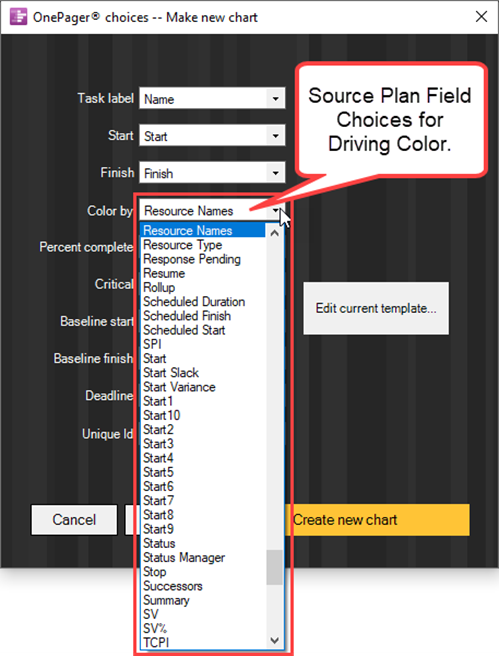
The Color by dropdown contains a list of all source plan fields that OnePager encountered in its initial import of your source plan's data. As a short aside, the Conditional Import Filters feature should be a considered factor as well.
For more information about Conditional Import Filters, please see the article at: Conditional Import Filters (Portal)
Template Properties Form's Task Bars Tab
The initial selection of Resource Names in the illustration above is taken from the current Template Properties form's Task Bars or Milestone tab's Task Bars/Milestone Fill Color control group being used in the process to create the chart as shown here:
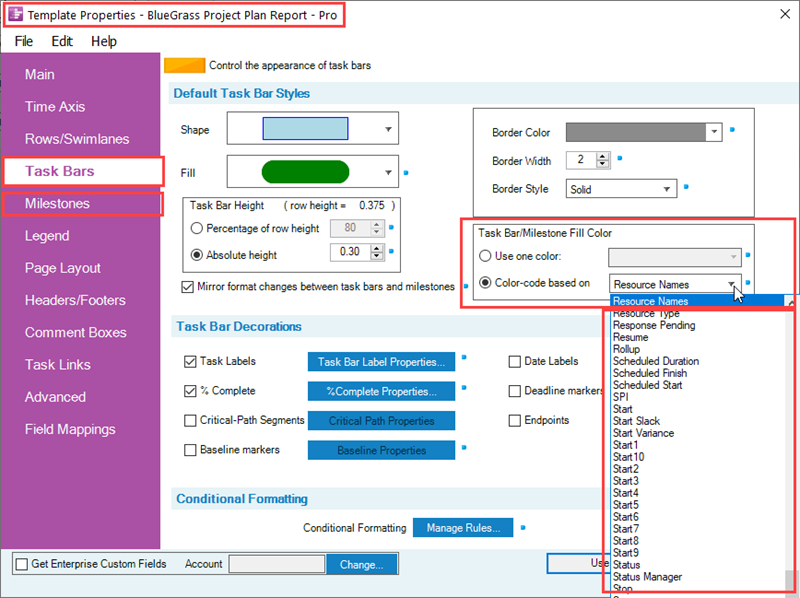
Shown in the above illustration, the Color-code based on radio button is selected and the Microsoft Project or Excel field name of Resource Names is selected from the dropdown list.
For Template Properties forms distributed for OnePager Pro, the Color-code based on field is preset to Resource Names since every Microsoft Project source plan contains this field. For Template Properties form's distributed for OnePager Express, the Color-code based on field is filled by OnePager Express based on an examination of the Microsoft Excel row 1 contents in the source plan and an educated guess on a suitable field to use. You can always change this field upon creation of the OnePager Express chart when you encounter page 2 of the OPC form.
Selecting another Microsoft Project or Excel field for the Color-code based on window in the Template Properties form also changes the value in the Color by dropdown list field selected in the second page of the OnePager choices (OPC) form also shown above. Regardless of whether the Template Properties form is updated as described above or you continue to use the original Color-code based on value for the color dimension in the chart, clicking the Create New Chart button at the bottom of the second page of the OPC form produces the first chart in the Chart Editor using the selected Microsoft Project or Excel field to drive the color selection. As a convenience, OnePager, when creating the first chart, uses a round-robin color assignment scheme to assign specific colors to task bar/milestone symbols based on their corresponding value found for the Color-code based on field. That is, all task bar/milestone symbols in the chart with the same value for Resource Names in this case display the same color.
Example Chart
A typical chart is shown below where the Color-code based on value is Resource Names and the round-robin color assignment scheme is used:
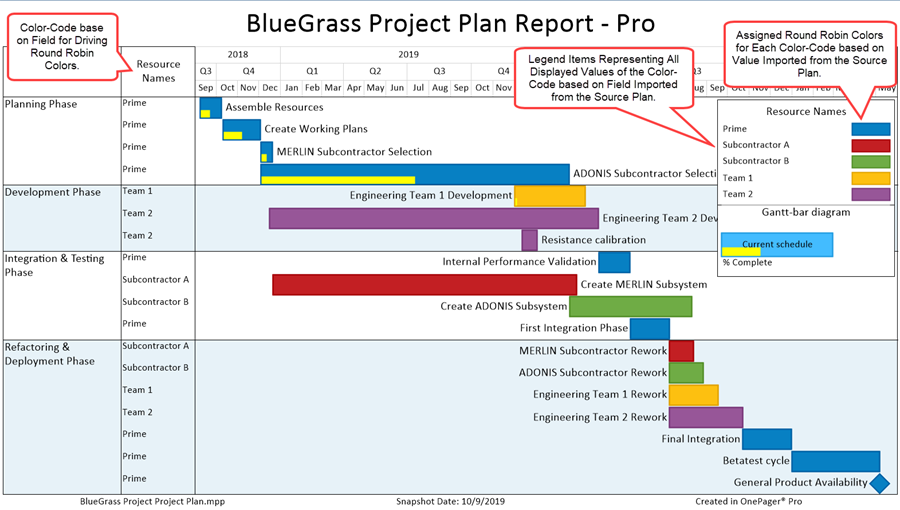
Once the chart is created, OnePager assures that the same colors representing the values of the selected Color-code base on value for each task bar/milestone symbol is maintained as snapshots are added to the chart. This feature assures that there is color use continuity, including within the Legend, for all snapshots as long as you do not manually maverick or change the color assignments later on.
References to More Legend Articles
Reference is made in the table below to the other articles in this series that deal with detailed editing, positioning, and the controls provided to accomplish these functions:
| Legend Position Options for Multi-Page Outputs | |
| Legend Editing Controls for OnePager Pro | Legend Editing Controls for OnePager Express |
The remainder of this article deals with how to show or hide the Legend in the chart and how to show or hide individual Legend Items.
For more information on editing task bar/milestone symbols and text labels in the chart, please see the articles at: Manual Editing Task/Milestone Shapes and Text Labels (Portal)
Showing and Hiding the Legend
Given the assumption that the chart is created with a Legend being displayed, you have controls available to show or hide the Legend as desired.
Global and Chart Level Controls for Showing or Hiding the Legend
The Template Properties form establishes the color dimension for the chart. The Template Properties form has a Legend tab containing controls for establishing global settings for the Legend as shown below:
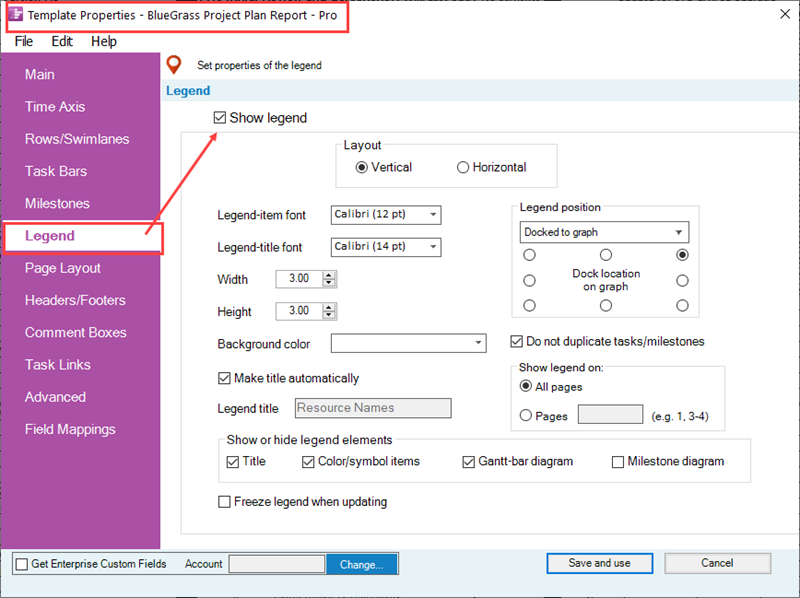
The governing control is the Show legend checkbox. Checking the Show legend checkbox ON enables all the controls in the tab and, when the Save and use button at the bottom of the form is clicked, the Legend appears in the chart. Checking the Show legend checkbox OFF disables all controls in the tab and, when applied, the Legend is no longer visible in the chart. The controls in the Template Properties form's Legend tab are replicated in the Chart Properties form's Legend tab.
Using the Chart Properties Form
Discussions on the controls in the Chart Properties form's Legend tabs for OnePager Pro and Excel can be found at:
| Legend Editing Controls for OnePager Pro | Legend Editing Controls for OnePager Express |
Using the OnePager View Ribbon Tool Bar Tab to Show or Hide the Legend
The OnePager View ribbon tool bar tab has controls for showing/hiding chart components as shown below:

The illustration above shows the Legend checkbox in the Graphic elements control group of the View ribbon tool bar tab on the ribbon checked ON. In this configuration, the Legend is shown in the chart. Checking the Legend checkbox OFF hides the Legend from view in the chart.
Hiding the Legend in A Snapshot
When the Legend checkbox is checked ON, the Legend appears in all snapshots. In a chart with multiple snapshots, the Legend can be shown or hidden in individual snapshots by using the legend right-click context menu's Hide legend command as shown here:

Moving and Resizing the Legend
Moving the Legend Using Drag and Drop
With the Legend displayed in the chart, the Legend itself can be moved manually with the select, drag, and drop operation. Use the mouse left click button to select a white space location inside the Legend box. Holding down the mouse left click button, drag the mouse to the new desired location. The mouse cursor is in the shape of a four-headed arrow shape at the location corresponding to the location originally selected in the Legend box in its original position. During the drag operation, the Legend box outline is displayed as shown below:
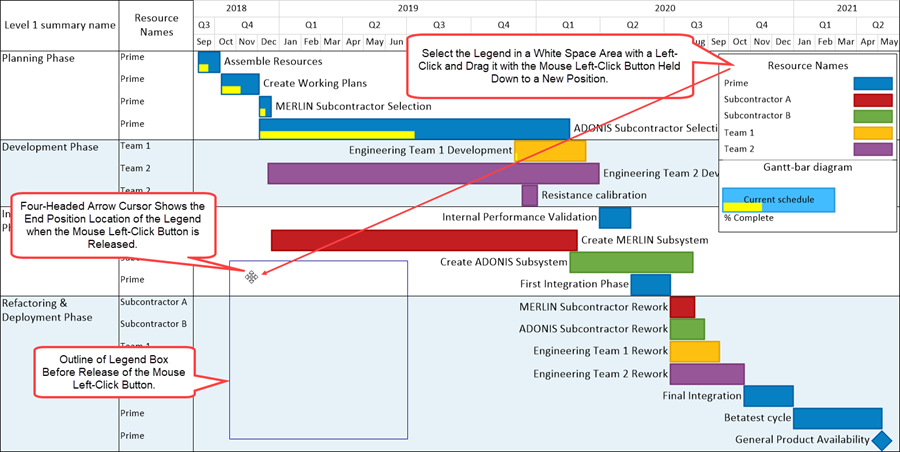
When the mouse left-click button is released, the Legend box is displayed in its new position as shown here:
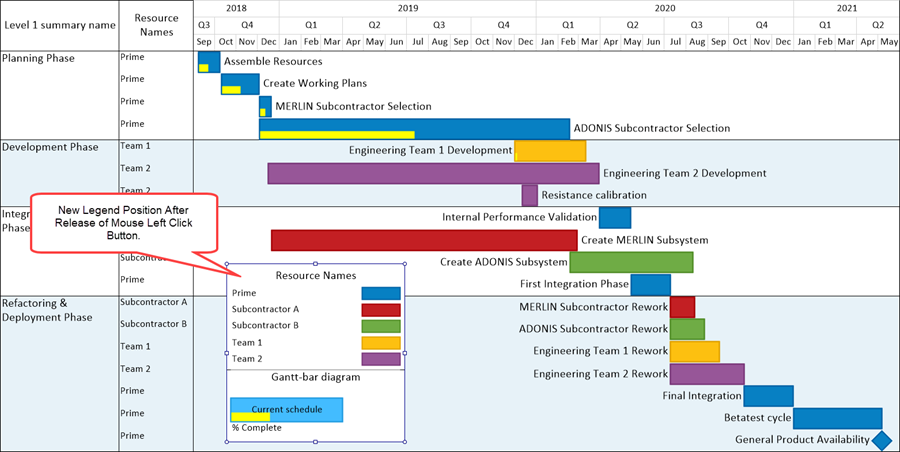
Repositioning the Legend Using the Controls in the Template Properties and Chart Properties Form's Legend Tab
There are controls provided in the Template Properties and Chart Properties form's Legend tab for you to establish one of eight (8) Legend position options under four (4) anchoring/docking options. These controls are shown here for illustration purposes for the Chart Properties form's Legend tab:
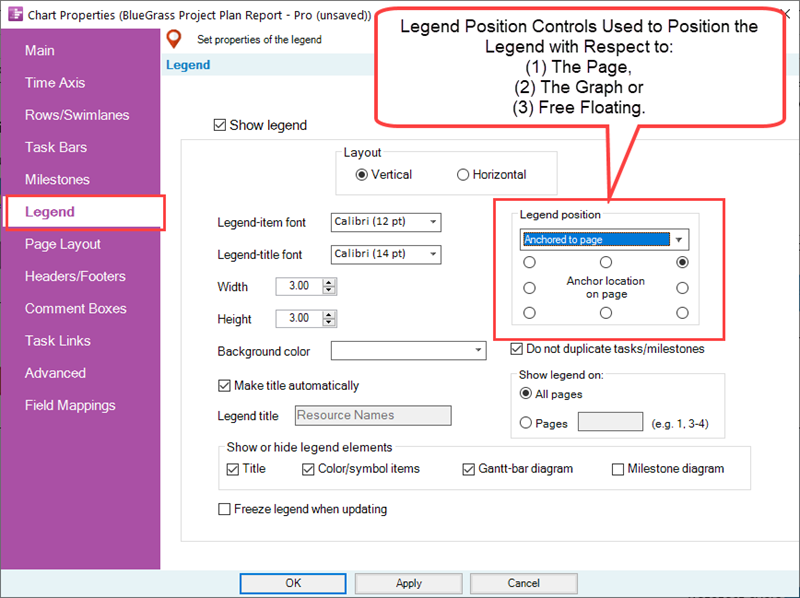
Legend positioning has some complicating implications in the context of multi-page output media and is further complicated when rows and swimlanes are also considered in multi-page output media presentations.
Given these implications, detailed instructions for using the controls shown above are provided in the article at: Legend Position Options for Multi-Page Outputs
Manually Resizing the Legend
If you select the Legend with a mouse left click, it resembles a Free box in terms of the eight grab boxes and circles that appear on its border as shown here:

The resizing approach for Legend is the same for the Free boxes. Mouse over one of the grab boxes or circles until the mouse cursor becomes a double-arrow shape. Hold down the mouse left click button at which point the mouse cursor becomes a plus sign and the border of the Legend is represented by a thin line. Continue to hold down the mouse left click button and drag the plus sign cursor in the allowable direction until the Legend is resized. Release the mouse left click button to complete the operation at which point the Legend is resized.
For reference to the resizing of Free boxes please see the section in the article at: Creating and Managing Free Boxes-Resizing a Free Box
Resizing the Legend Using the Controls in the Template Properties and Chart Properties Form's Legend Tab
There are controls provided in the Template Properties and Chart Properties form's Legend tab for you to edit the dimensions/size of the Legend . These controls are shown here for illustration purposes for the Chart Properties form's Legend tab:
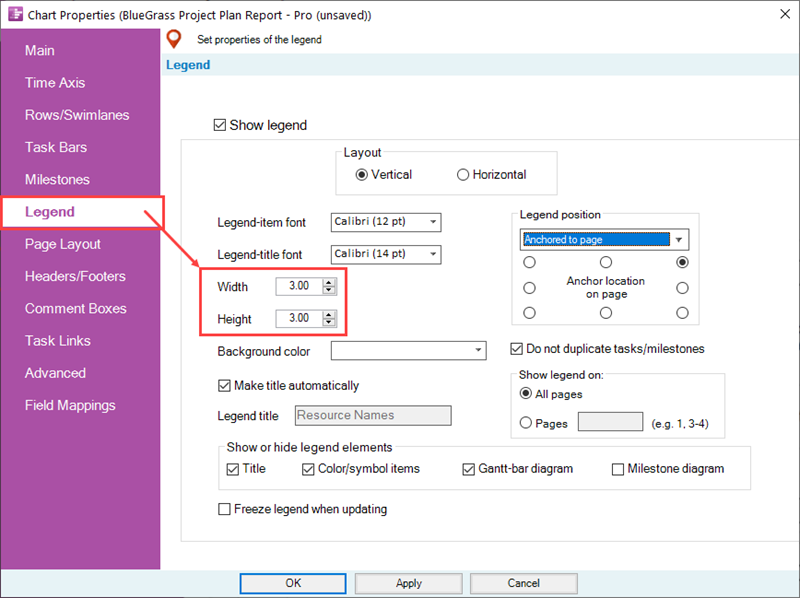
Legend resizing using the controls in the Legend tab of the Chart Properties form is done exactly like using the corresponding controls for the Comment box at the Chart Properties form's Comment Box tab.
Given the similarity, detailed instructions for using the resizing controls shown for the Comment box can be found in the section in this article at: Creating and Managing Comment Boxes-Box Size Controls for Comment Boxes
Showing and Hiding Individual Legend Items
There are occasions where you might want to hide an individual Legend item from view in the Legend. This might be the case because you've manually hidden a particular task bar/milestone symbol corresponding to that Legend item. Additionally, there are instances where the Legend displays duplicate Legend items as a result of Conditional Formatting Rules.
For more information on Conditional Import Rules, please see the articles at: Conditional Import Filters (Portal)
Typically, the Legend is built showing all the Legend items acquired from the import of source plan data corresponding to the Color-code based on value selected.
Selecting a Legend Item to Hide
With the Legend in its entirety showing in the chart, use the mouse to right click on the Legend item name or the Legend item's color shape which accesses the Edit Legend Item form shown below:

Hide the Selected Legend Item
When you check the Show Legend Item checkbox OFF, the selected Legend item is hidden in the Legend as shown here:

Restoring a Hidden Legend Item
Legend items can always be made to show later by right-clicking in the Legend in white space to access the legend right-click context menu and then clicking the Unhide all items command as shown below:
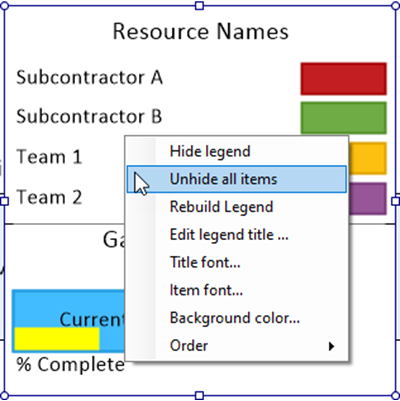
After the Unhide all items command is clicked, the Legend looks like this:
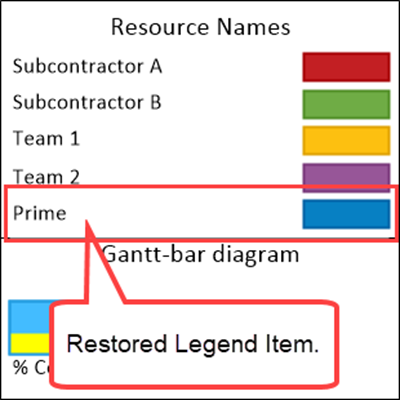
Please note that the restored previously hidden Legend item may not be shown in its original position in the Legend as shown above. There are controls in the Edit Legend Item form, discussed above where you can change the position of any Legend item showing in the Legend as illustrated here:

Instructions for using the other controls in the Edit Legend Item form are found in the article at: Editing, Repositioning Legend Items, and Formatting the Legend
Related Links
Conditional Import Filters (Portal)
Manual Editing Task/Milestone Shapes and Text Labels (Portal)
Creating and Managing Comment Boxes. 13.0.1-70
Creating and Managing Free Boxes-Resizing a Free Box
(15.1.1-70)